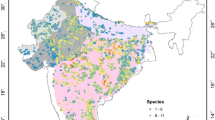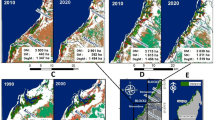Abstract
Automated plant detection plays a pivotal role in various domains, including agriculture, environmental monitoring, and biodiversity conservation. In this paper presents a novel deep learning model specifically designed for classifying the diverse flora of Saudi Arabia. To accomplish this task, a novel dataset was created, named SaudiArabiaFlora Dataset, comprising samples from ten distinct types of plants found across various regions of Saudi Arabia. Our novel database provides an extensive range of plant species. The proposed model, named MIV-PlantNet, leverages the strengths of three well-established architectures: MobileNet, Inception, and VGG. By combining their unique characteristics, the model aims to achieve superior performance in terms of classification accuracy, precision, and F1-score. Extensive experiments were conducted to evaluate the model’s efficacy, and comparisons were made with state-of-the-art models such as MobileNet, Inception, and VGG. The results demonstrate that the MIV-PlantNet deep learning model achieved an outstanding accuracy of 99%. Moreover, it demonstrates remarkable precision at 96% and an outstanding F1-score of 98%, underscoring its robustness and reliability. To gain insights into the model decision-making process, we utilized visual explainable AI approaches, specifically SHAP (SHapley Additive exPlanations). This analysis reveals the essential elements contributing to model predictions, enhancing our understanding of the classification process and model behavior. The findings of this study have substantial implications, accurate plant classification in Saudi Arabia has significant implications for biodiversity preservation and ecological studies. Our Dataset and MIV-PlantNet model offers exceptional resources and valuable insights for automated plant detection in various fields.














Similar content being viewed by others
Data availability
The dataset is available upon request. Due to the proprietary nature of the dataset, it is subject to certain restrictions and usage agreements. Interested researchers can contact the corresponding author to obtain access to the dataset. The availability of this dataset aims to promote transparency, reproducibility, and collaboration in the field of plant detection research.
References
Abu-Jamie TN et al (2022) Six fruits classification using deep learning. Int J Acad Inf Syst Res 6(1):1–8
Alam S, Raja P, Gulzar Y (2022) Investigation of Machine Learning Methods for Early Prediction of Neurodevelopmental Disorders in Children. Wirel Commun Mob Comput 2022:1
Alsaedi N, Alahmadi H, Syed L (2022) Deep learning technique for dessert plant classification and recognition. Lecture Notes of the Institute for Computer Sciences, Social-Informatics and Telecommunications Engineering, LNICST, 438 LNICST, 182–194. https://doi.org/10.1007/978-3-031-04409-0_17
Amri E, Dardouillet P, Benoit A, Courteille H, Bolon P, Dubucq D, Credoz A (2022) Offshore Oil Slick Detection: From Photo-Interpreter to Explainable Multi-Modal Deep Learning Models Using SAR Images and Contextual Data. Remote Sens 14:3565. https://doi.org/10.3390/rs14153565
Ariunzaya G, Kavalan JC, Chung S (2023) Identification of seed coat sculptures using deep learning. J Asia-Pac Biodivers. 16(2):234–245. https://doi.org/10.1016/j.japb.2022.11.006
Batchuluun G, Nam SH, Park KR (2022) Deep learning-based plant classification and crop disease classification by thermal camera. J King Saud Univ Comput Inform Sci 34:10474–10486. https://doi.org/10.1016/j.jksuci.2022.11.003
Benoit A, Ghattas B, Amri E, Fournel J, Lambert P (2021) Deep learning for semantic segmentation. Multi-Faceted Deep Learn Models Data. https://doi.org/10.1007/978-3-030-74478-6
Cumo C (2015) Plants and people: origin and development of human—plant science relationships. CRC Press (ISBN 1498707092)
Diaz M, Medina Castaneda EE, Mugruza Vassallo CA (2019) Deep learning for plant classification in precision agriculture.In: 2019 International Conference on Computer, Control, Informatics and its Applications (IC3INA), Tangerang, Indonesia, pp. 9–13. https://doi.org/10.1109/IC3INA48034.2019.8949612
Duong-Trung N, Quach LD, Nguyen MH, Nguyen CN (2019) A Combination of Transfer Learning and Deep Learning for Medicinal Plant Classification. ACM International Conference Proceeding Series, Part F147957, 83–90. https://doi.org/10.1145/3321454.3321464
Emna A, Alexandre B, Bolon P, Véronique M, Bruno C, Georges O (2020) Offshore Oil Slicks Detection From SAR Images Through The Mask-RCNN Deep Learning Model. Int Joint Conf Neural Netw. https://doi.org/10.1109/IJCNN48605.2020.9206652
Gulzar Y, Alwan AA, Abdullah RM, Abualkishik AZ, Oumrani M (2023) OCA: ordered clustering-based algorithm for e-commerce recommendation system. Sustainability 15:2947. https://doi.org/10.3390/su15042947
Hossain MS, Al-Hammadi M, Muhammad G (2018) Automatic fruit classification using deep learning for industrial applications. IEEE Trans Industr Inf 15(2):1027–1034. https://doi.org/10.1109/TII.2018.2875149
Knapič S, Malhi A, Saluja R, Främling K (2021) Explainable Artificial Intelligence for Human Decision Support System in the Medical Domain. Mach Learn Knowledge Extraction 3:740–37770. https://doi.org/10.48550/arXiv.2105.02357
Krizhevsky A, Sutskever I, Hinton GE (2012) Imagenet classification with deep convolutional neural networks. Adv Neural Inform Proces Syst. https://doi.org/10.1145/3065386
Lauriola I, Lavelli A, Aiolli F (2022) An Introduction to Deep Learning in Natural Language Processing: Models, Techniques, and Tools. Neurocomputing 470:443–456. https://doi.org/10.1016/J.NEUCOM.2021.05.103
Linardatos P, Papastefanopoulos V, Kotsiantis S (2021) Explainable AI: a review of machine learning interpretability methods. Entropy 23:18. https://doi.org/10.3390/e23010018
Lundberg SM, Allen PG, Lee S-I (2017) A unified approach to interpreting model predictions. Adv Neural Inf Process Syst. https://doi.org/10.48550/arXiv.1705.07874
Minaee S, Boykov Y, Porikli F, Plaza A, Kehtarnavaz N, Terzopoulos D (2021) Image segmentation using deep learning: a survey. IEEE Trans Pattern Anal Mach Intell 44(7):3523–3542. https://doi.org/10.1109/TPAMI.2021.3059968
Mohanty SP, Hughes DP, Salathé M (2016) Using deep learning for image-based plant disease detection. Front Plant Sci 7:215232
Mosaffaei Z, Jahani A, Chahouki MAZ et al (2020) Soil texture and plant degradation predictive model (STPDPM) in national parks using artificial neural network (ANN). Model Earth Syst Environ 6:715–729. https://doi.org/10.1007/s40808-020-00723-y
Ouyang F, Zheng L, Jiao P (2022) Artificial intelligence in online higher education: A systematic review of empirical research from 2011 to 2020. Educ Inf Technol 27:7893–7925. https://doi.org/10.1007/s10639-022-10925-9
Pathak AR, Pandey M, Rautaray S (2018) Application of deep learning for object detection. Proc Comput Sci 1(132):1706–1717. https://doi.org/10.1016/j.procs.2018.05.144
Pound MP, Atkinson JA, Wells DM, Pridmore TP, French AP (2017) Deep learning for multi-task plant phenotyping. In: Proceedings of the Proceedings of the IEEE International Conference on Computer Vision Workshops, pp. 2055–2063. https://doi.org/10.1109/ICCVW.2017.241
Qurashi JM, Jambi KM, Eassa FE, Khemakhem M, Alsolami F, Basuhail AA (2023) Toward Attack Modeling Technique Addressing Resilience in Self-Driving Car. IEEE Access 11:2652–2673. https://doi.org/10.1109/ACCESS.2022.3233424
Sai K, Prabalakshmi A, Alagammal S (2021) A comparative study on plant classification performance using deep learning optimizers. In: 2021 Emerging Trends in Industry 4.0 (ETI 4.0) May 19 (pp. 1–9). IEEE. https://doi.org/10.1109/ETI4.051663.2021.9619238
Saint-Fleur BE, Allier S, Lassara E et al (2023) Towards a better consideration of rainfall and hydrological spatial features by a deep neural network model to improve flash floods forecasting: case study on the Gardon basin, France. Model Earth Syst Environ 9:3693–3708. https://doi.org/10.1007/s40808-022-01650-w
Sandler M, Howard A, Zhu M, Zhmoginov A, Chen L-C (2018) Mobilenetv2: inverted residuals and linear bottlenecks. In: Proceedings of the Proceedings of the IEEE conference on computer vision and pattern recognition; pp. 4510–4520. https://doi.org/10.48550/arXiv.1801.04381
Sculley D, Snoek J, Wiltschko A, Rahimi A (2018) Winner’s curse? On pace, progress, and empirical rigor. In: Proceedings of the ICLR 2018 Workshop; May 5
Sghir N, Adadi A, Lahmer M (2023) Recent advances in predictive learning analytics: A decade systematic review (2012–2022). Educ Inf Technol 28(7):8299–8333. https://doi.org/10.1007/s10639-022-11536-0
Simonyan K, Zisserman A (2014) Very deep convolutional networks for large-scale image recognition. arXiv preprint arXiv:1409.1556. https://doi.org/10.48550/arXiv.1409.1556
Simpson MG (2019) Plant systematics. Academic Press. https://doi.org/10.1016/C2015-0-04664-0 (ISBN 0128126280)
Sujatha R, Chatterjee JM, Jhanjhi NZ, Brohi SN (2021) Performance of deep learning vs machine. Microprocess Microsyst. https://doi.org/10.1016/j.micpro.2020.103615
Szegedy C, Vanhoucke V, Ioffe S, Shlens J, Wojna Z (2016) Rethinking the Inception Architecture for Computer Vision. In: Proceedings of the Proceedings of the IEEE conference on computer vision and pattern recognition, pp. 2818–2826. https://doi.org/10.48550/arXiv.1512.00567
Thanmai BT, Vani K, Srihith ID, Sai IV, Shasikala I (2023) Revolutionizing Healthcare with Deep Learning. Recent Trends Inform Technol Appl 6(3):16–30. https://doi.org/10.5281/zenodo.8138446
Van Lent M, Fisher W, Mancuso M (2004) An explainable artificial intelligence system for small-unit tactical behavior. In: Proceedings of the national conference on artificial intelligence. AAAI Press, MIT Press, Menlo Park, CA, Cambridge, MA, London, pp 900–907
Yalcin H, Razavi S (2016) Plant classification using convolutional neural networks. 2016 5th International Conference on Agro-Geoinformatics, Agro-Geoinformatics. https://doi.org/10.1109/Agro-Geoinformatics.2016.7577698
Yang H, Ni J, Gao J, Han Z, Luan T (2021) A novel method for peanut variety identification and classification by Improved VGG16. Sci Rep 11(1):15756
Zamri N, Pairan MA, Azman WNAW et al (2023) Finding optimal strategies for river quality assessment using machine learning and deep learning models. Model Earth Syst Environ 9:615–629. https://doi.org/10.1007/s40808-022-01494-4
Acknowledgements
We acknowledge the generous support provided by the Deanship of Scientific Research, Vice Presidency for Graduate Studies and Scientific Research, King Faisal University, Saudi Arabia, under project number GRANT5,235.
Author information
Authors and Affiliations
Corresponding authors
Ethics declarations
Conflict of interest
The Authors declares that there is no conflict of interest associated with this research.
Ethical approval
This article does not contain any studies with human participants or animals performed by any of the authors.
Informed consent
Informed consent was obtained from all individual participants included in the study.
Consent to publish
All individual participants consent to publish this article.
Additional information
Publisher's Note
Springer Nature remains neutral with regard to jurisdictional claims in published maps and institutional affiliations.
Rights and permissions
Springer Nature or its licensor (e.g. a society or other partner) holds exclusive rights to this article under a publishing agreement with the author(s) or other rightsholder(s); author self-archiving of the accepted manuscript version of this article is solely governed by the terms of such publishing agreement and applicable law.
About this article
Cite this article
Amri, E., Gulzar, Y., Yeafi, A. et al. Advancing automatic plant classification system in Saudi Arabia: introducing a novel dataset and ensemble deep learning approach. Model. Earth Syst. Environ. 10, 2693–2709 (2024). https://doi.org/10.1007/s40808-023-01918-9
Received:
Accepted:
Published:
Issue Date:
DOI: https://doi.org/10.1007/s40808-023-01918-9




